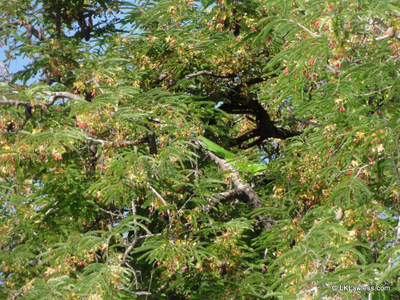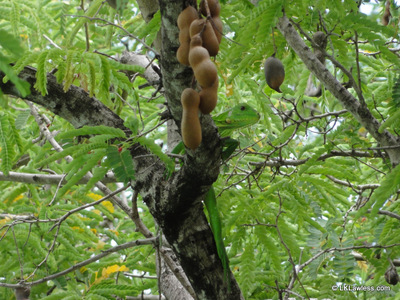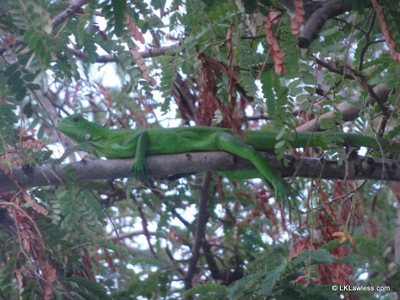
(Click photos to embiggen.) One iguana that has been around for a while is a young one, perhaps 2-3 years old, who lives in our tamarind tree. This spectacular tree, which we call Tommy, deserves a story all its own, but for now I’ll just tell you that it’s at least 100 years old, about 35 feet tall, and stands below / next to the suspended end of our pool, with a few branches that extend over it.
A few months ago, the husband and I started finding small poop pellets in the pool. Since we’re always skimming Tommy’s colorful leaves and blossoms off the surface, it’s no hardship to collect the poop at the same time, but it did seem curious. It didn’t take long to realize that a young iguana was the culprit. He’d crawl out onto one of Tommy’s overhanging branches in order to – deliberately – poop in the pool. The rest of the time he hangs out in other branches, but he seems to think that the pool is his personal toilet. (Can’t help wondering what he thinks about the creatures who spend so much time swimming in it.) Since we love iguanas, we figure it’s a fair trade: we clean up his poop in exchange for getting to see him. So of course we named him Poopy.

Then about a month ago, Poopy apparently decided to stop toying with us. He stuck to a routine: on one of a handful of branches next to and about 6 feet above the pool, from mid-afternoon until late morning, every day. Our best guess is that he goes elsewhere for lunch: either a different part of Tommy or, more likely, on the ground. So for a couple of weeks, we knew he’d always be there for sunrise and sunset swims, but not at lunchtime.
And then Maria hit. The evening before the storm, Poopy was on one of his usual branches, hanging on for dear life in the wild winds. I like to think that he was enjoying the adrenaline rush, but maybe he was just too scared to try to crawl down to the ground and find a safer place. Either way, in between worrying about the apocalyptic noises during the storm, I worried about him. When it was finally safe to go outside, I checked Tommy, but of course Poopy wasn’t there. (Nor were some of Tommy’s branches, many of his leaves, or any of his orchid-like flowers.) I checked every day, morning-noon-night for a week, but Poopy was never there. I wondered if he’d been hurt or killed by Maria, or whether Tommy was no longer lush enough to intrigue him. I read an article about how iguanas are sometimes transported out to sea during hurricanes. They find a makeshift raft – sometimes along with other iguanas – and float to other islands, so I imagined him starting a new life in a new tree somewhere across the water.
